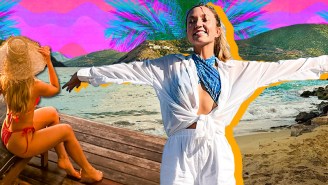Yellowstone National Park is one of the big ones. One of the places you’ve probably “always been meaning to get to.” It’s bucket list fodder — sprawling and epic and legendary — like the Grand Canyon or the Everglades.
People love Yellowstone. But that love comes at a cost: This year, the park is on track to receive more than four million visitors. The lion’s share of those come in the summer. During this high season, the idea of being in the “wild” in Yellowstone is almost absurd. On any given summer day, the park features more people snapping selfies than the Sunday brunch rush in Brooklyn.
Luckily, summer isn’t the only good time to visit. Yellowstone is a park with four clearly definable seasons and even seasons inside of seasons with distinct differences — like mid-winter vs. late-winter. Late-winter gives off a far less terminal vibe than mid-winter; it’s a bit more hopeful, so to speak.
Right now, Yellowstone is in the late-fall/early-winter season and if your Yellowstone dreams are about big, brawling, wilderness, uninterrupted by modern machinery, then now is the best time to visit Yellowstone.
Here’s why:
IT’S NOT SO COLD THAT EVERYTHING SUCKS…
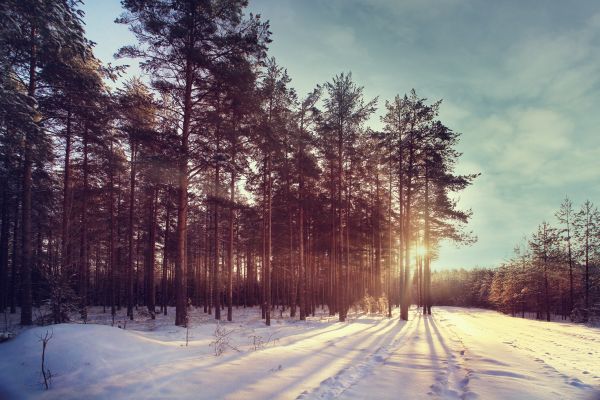
On a year to year basis, Yellowstone will have some of the coldest temperatures in the lower 48 states. It routinely gets down into the nostril-hair-icing-up level. Which, for this correspondent, is a very un-fun climate to spend time in. I know that some people really savor extreme cold — my sister, a glaciologist, thrives in those conditions — but for me, the second the temp drops below 0-degrees fahrenheit, my motivation to do anything besides rub my stocking-covered feet together plummets severely.
Right now, temperatures at the West Yellowstone gate are hovering around freezing. That’s perfect. Freezing, I can handle (with a little layering). Freezing feels bracing. You feel alive at 32-degrees. Even at 10-degrees. But when it gets to real winter, and those temps are in the -30s, it’s pretty near impossible to get motivated for any exploration outside of the fireplace’s warming glow.
…BUT STILL COLD ENOUGH FOR A COZY CABIN.
Even though I don’t like ultra-cold temperatures, it is nice to experience some variance. Just enough so that at the end of the day, when the sun drops below the horizon, you’re left craving a fire and some cocoa. On my most recent late-fall trip that was the first thing I did post-sunset every single day: settled down by the fire with cocoa to play backgammon. It’s the definition of the Danish term “hygge” — that special communal-feeling brand of coziness.
Better still, you feel like it’s coziness well-earned because you’ve moved around all day. You even feel like you deserve a big dinner and a Wyoming craft beer after cross-country skiing and throwing handfuls of gorp into your mouth.
Where to stay: Options in the park are limited this time of year, but the Explorer Cabins in West Yellowstone make a perfect base. These free-standing cabins were private and cozy enough to give that winter in the woods feel — but they’re also situated together so that you can travel in groups.
THERE ARE WAY LESS HUMANS…
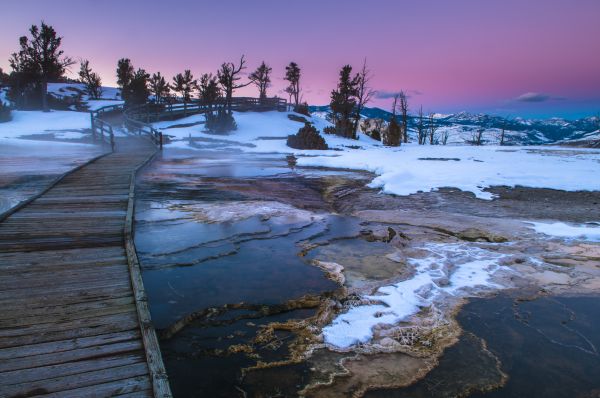
Late November/early December is by far the lowest visitation period for the park. On average, the month of November accounts for only .45% of Yellowstone’s yearly guests. Still, most of those come early in the month, before the roads close. In mid-late November, the roads are completely closed and the park isn’t yet open to snowmobiles.
Meaning: if you go now, you’ll experience Yellowstone without a single motor vehicle. You can cross-country ski or snowshoe along the roads without the hassles of giant motorcades. Anyone who has witnessed park traffic grinding to a dead halt because of a passing buffalo in the summer will understand immediately how cool this possibility is. But it won’t last — the park opens to snowmobiles on December 15th and while snowmobiles are fun, they damn sure aren’t tranquil.
Rent: skis or snowshoes at Free Heel & Wheel — which is also a great place to lay out your plan for the day, get local advice, and grab a nice cup of coffee.
…BUT WAY MORE ANIMALS
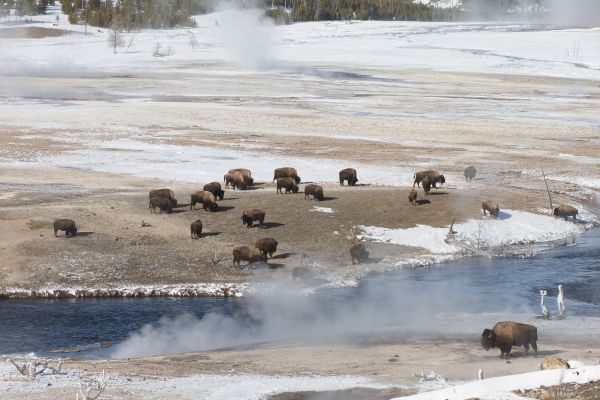
Believe it or not, having a bunch of cars rumbling around isn’t the best way to spot wildlife. But the gentle whooshing of cross-country skis or thwapping of snow shoes? That’s like a siren song for elk, coyotes, and moose. They’re closer to the roads (because there are less cars) and easier to spot (because there’s a dusting of snow on the ground).
Animals also spend more time grazing in the valleys in the valleys in late fall. Bull elk — skinny from rutting season — will be trying to regain fat reserves as fast as they can before true winter sets in. If you’re really lucky, you might spot a bear digging its winter den on a nearby hill.
THERMAL FEATURES ARE MORE DRAMATIC…
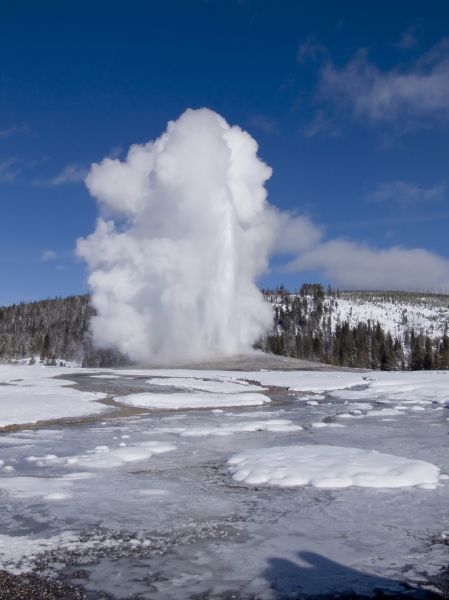
This one doesn’t need too much explanation. The temperature difference between a geyser or bubbling pot and the cold air is greater than in summer — therefore more steam is created. Also, to see one of these thermal features they way an explorer might have, by noticing it organically rather than having it screamed to you through a bus intercom feel adventurous and bold.
…AND HOT SPRINGS ARE MORE VITAL
https://www.instagram.com/p/9evaJ5wUcQ/
Let’s call this the “because you need it” corollary. A hot spring in the summer is cool. But in the early-winter, when the air outside is still just barely tolerable, a hot spring is pure bliss. It actually feels like a utility rather than just a fun thing to try.
You need it to warm and soothe you and that makes the experience so much better.
The most famous hot springs in the park is the Boiling River near the North Gate. To get there from West Yellowstone in late Nov./early Dec., you’ll have to travel the long way around, through Bozeman. Alternately, Norris Hot Springs is just outside of the park, open year round, and easily accessible from the Explorer Cabins.
* * *
If we’re speaking the dead-solid truth, visiting Yellowstone during the stretch between late fall and early winter isn’t for everyone. It’s definitely not the easiest time, nor the most convenient time. You can’t see all of the park without some insane-level effort so you’ll have to embrace missing things…
But if you like your national parks wild and untouched and raw, this is undoubtedly the very best time go to Yellowstone. I’ll see you there.
**KEEP UP ON CURRENT CONDITIONS/ROAD CLOSURES IN THE PARK BEFORE YOU GO.**





